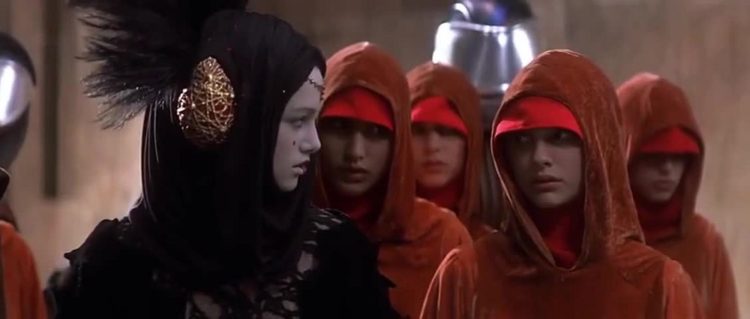
There’s a certain type of Star Wars film-adjacent novel that I like to call a “movie explainer.” Best exemplified by the Darth Plagueis novel of the Legends era, it’s a book that has its own story but also seems to some readers to “fix” or “explain” a film in a way not seen on screen. Sometimes people want Star Wars books to do this – we’ve all seen the tendency recently to want movie novelizations in particular to “fix” something people didn’t like in the movie.
There’s another kind of Star Wars film-adjacent novel: the backstory novel. These novels either introduce us to the new characters from the film or they provide more story for characters we’ve just met on screen. The novels around Rogue One are a great example of these – Del Rey’s Catalyst and Disney’s Rebel Rising and Guardians of the Whills were brilliantly well-received introductions and expansions to Rogue One.
Queen’s Peril, by E.K. Johnston, is definitely a movie-adjacent novel – but it’s neither a “movie explainer” nor a backstory novel. It runs partially concurrent to the events of The Phantom Menace and sheds new light on the film, but not out of a desire to “fix” the movie or to add lore for the sake of lore. If you’ve read Johnston’s first Padmé book, Queen’s Shadow, you know what to expect: it’s a novel about Padmé and her handmaidens and their relationship to each other as they navigate the strangeness of Naboo politics. Queen’s Peril adds context and backstory to The Phantom Menace and reinforces how we should’ve seen the film all along. How? By reminding us of one thing: Queen Amidala is the main hero of The Phantom Menace.
How to add to a film instead of detract from it
The novel is all about Padmé and her handmaidens. They’re the main characters of the book. In a certain sense, Padmé and Sabé are still the main protagonists – but we get the POVs of the other handmaidens, Captain Panaka, and several other characters as well. The book is very much about how Padmé and her handmaidens build the person of “Queen Amidala,” who is more than just Padmé and her occasional decoy Sabé. She’s an amalgam of all the handmaidens, who bring all their strength and expertise to the table.

And this is how Queen’s Peril adds to the experience of The Phantom Menace: through the composite character of Queen Amidala. I remember a convention panel about the film where the panelists were scratching their heads trying to figure out if The Phantom Menace had a main character. My friend Bria, as an audience member, pointed out to the panel that Padmé Amidala was the main protagonist of the film: and suddenly, everything clicked for the panel. It’s something that was obvious to some – including the women and girls who definitely recognized Padmé as a hero – but seems to have escaped the notice of others until it’s pointed out to them.
But Queen’s Peril isn’t just a backstory novel about the existing character of Queen Amidala, because it’s about a whole group of women who make the Naboo monarch possible. And that’s how the book changes how we see The Phantom Menace: by providing us insight into the creation of this composite character and insight into the people that make her up.
Saying more about characters we know
Chronologically, Queen’s Shadow takes place after The Phantom Menace and explores Padmé’s transition to the role of Naboo’s senator – but Queen’s Peril takes place before The Phantom Menace and explores Padmé becoming Queen of Naboo in the first place, making it a backstory not just to The Phantom Menace but to Johnston’s first Padmé novel as well.
For anyone who’s read Queen’s Shadow, the handmaidens are something of a known quantity by now. We know their personalities and expertise well enough that we could write a “Which Handmaiden Are You?” personality quiz. For anyone who hasn’t read it, they might be brand-new figures to them. Queen’s Peril introduces us to the handmaidens in a way that suits both kind of readers.
The book has interlude sections throughout the novel that introduce us to each of the young women and who they were before they were selected to become handmaidens. These interludes are probably my favorite part of the book because of the insight they give us into their personalities, and they’re honestly pretty fun reads. I won’t dare spoil why – only to say that I’m glad they’re included.

Most of the early part of the book involves Padmé getting used to the idea of being queen, having a security detail in Captain Panaka, and having handmaidens in the first place. I particularly enjoyed how all of these scenes were crafted, and how navigating issues of friendship, hierarchy, and personality wouldn’t exactly be the easiest thing in the world. Especially when the monarch and her handmaidens are teenagers – there are some predictable problems but some surprising solutions, as these teenagers are not to be underestimated.
It turns out that the smoothly-functioning setup of the handmaidens seen in the film had some rough spots, but Queen’s Peril shows us how the group was set up and how they navigated their initial trials by fire. Padmé and Sabé are best friends in Queen’s Shadow, but this novel shows us how they got there. E.K. Johnston highlighted how the handmaidens use fashion as a weapon in her previous book, but now she shows us how that all got started.
There’s also a fair bit of dramatic irony where we know things from the previous novel that the characters don’t. Some of these things are great – and some of them are worrisome – and Johnston knows how to deliver both joy and pain to her readers.
The book is all about “Amidala”
Queen’s Peril is all about Padmé and her handmaidens, which seems a painfully obvious thing to say. It adds context and new meaning to The Phantom Menace, but via insights into the Queen of Naboo that’s formed up of Padmé, Sabé, Eirtaé, Rabé, Yané, and Saché. If you’re looking for insights on Republic tax policy…well, you’ll find those too, but they’re not the main focus (Johnston gave us a whole plot about senatorial committees on concrete last time, so of course she’d get into the tax thing!). Queen’s Peril is backstory, not a fix-it story, and it’s a backstory meant to service characters.
At the end of the day, I think Star Wars novels should be about characters and they should tell interesting stories. I love lore – I really do – and stories of bureaucracy and political machinations are my jam. That stuff’s all in here. But it’s not the main appeal. The main appeal is reading about these characters, and I appreciated how E.K. Johnston used her story about the queen and her handmaidens to enhance the story of Episode I, not shout over it.
